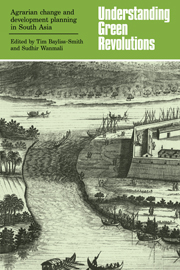Book contents
- Frontmatter
- Contents
- List of contributors
- Preface
- I Understanding Green Revolutions: an overview
- 1 The agricultural revolution in Western Europe
- 2 Land reform as a pre-condition for Green Revolution in Latin America
- 3 Frogs and farmers: the Green Revolution in India, and its murky past
- 4 Agrarian change and the Merchant State in Tamil Nadu
- II Agrarian change at village level
- III Development planning and agrarian change
- Index
2 - Land reform as a pre-condition for Green Revolution in Latin America
Published online by Cambridge University Press: 25 May 2010
- Frontmatter
- Contents
- List of contributors
- Preface
- I Understanding Green Revolutions: an overview
- 1 The agricultural revolution in Western Europe
- 2 Land reform as a pre-condition for Green Revolution in Latin America
- 3 Frogs and farmers: the Green Revolution in India, and its murky past
- 4 Agrarian change and the Merchant State in Tamil Nadu
- II Agrarian change at village level
- III Development planning and agrarian change
- Index
Summary
In most Latin American countries, land reform has been a burning issue for many years, flaring into activity from the 1950s to the early 1970s, but dying down in recent years except in Central America, and particularly in Nicaragua. The list of land reform legislation is formidable, beginning with the legislation of 1917 which followed the Mexican Revolution, and most recently expressed in the land reform of Nicaragua which followed the overthrow of Somoza in 1979.
Declining interest by governments, and in some instances, notably that of Chile since 1973, outright reversal of land reform, has been accompanied by a sense of disillusionment among reformists: disillusionment that legislation has not been put into effect; that relatively few peasants have benefited from land reform, even where it has been partially carried out; that many peasants, even among beneficiaries of reform, have been reluctant to abandon subsistence farming; that agricultural production, especially in the reform sector, has not responded to expectations; and that the rural sector has not been able to fulfil the prediction that increased and more equitable rural income would create demand for national industrial production.
The real impact of land reform
Yet the most significant results of the land reform movement seem to lie in other directions: a substantial increase in the intervention of the State in the agricultural sector; and a massive stimulus to the extension of capitalism in agriculture. State intervention is, of course, implicit in the whole process of land reform itself, but various mechanisms ensure continued State involvement.
- Type
- Chapter
- Information
- Understanding Green RevolutionsAgrarian Change and Development Planning in South Asia, pp. 18 - 36Publisher: Cambridge University PressPrint publication year: 1984
- 1
- Cited by



